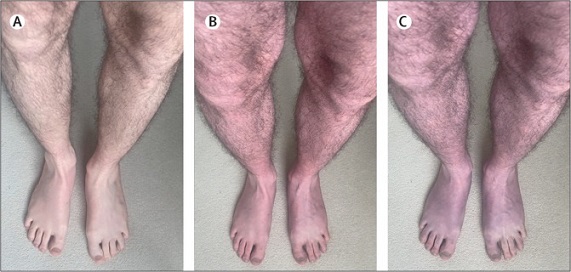UK Doctors Warn Of Venous Insufficiency And Acrocyanosis (Blue Legs) In Long COVID
Thailand Medical News Team Aug 12, 2023 2 years, 4 months, 1 week, 4 days, 13 hours, 23 minutes ago
COVID-19 News: The relentless march of the COVID-19 pandemic has left behind a trail of mysteries and lingering effects, some of which have only begun to unravel as scientists delve deeper into the intricate web of post-infection complications.
 Photographs of the patient's legs 0 min (A), 2 min (B), and 10 min (C) after standing
Photographs of the patient's legs 0 min (A), 2 min (B), and 10 min (C) after standing
Among these enigmatic phenomena, a peculiar case has emerged that sheds light on an alarming symptom affecting individuals dealing with long COVID: the unsettling transformation of legs into shades of blue. This captivating discovery underscores the urgency of heightened awareness surrounding this symptom within the long COVID community.
At the heart of this investigation lies the case study of a 33-year-old man whose battle with long COVID unveiled an astonishing transformation in his lower extremities. Acrocyanosis, a medical term denoting the blueness of the hands, feet, nose, and ears, emerged as a central theme in this patient's ordeal. In a dramatic twist, his legs would gradually turn shades of red and blue within mere minutes of standing, with veins becoming strikingly prominent. Within ten minutes, the transformation became pronounced, accompanied by an overwhelming sensation of heaviness and itching. However, a return to a non-standing position swiftly restored his legs to their original color.
This peculiar case holds significant implications for the understanding of long COVID and its far-reaching effects on the body. The patient, having previously contracted COVID-19, was subsequently diagnosed with postural orthostatic tachycardia syndrome (POTS), a condition marked by an abnormal increase in heart rate upon standing. Dr Sivan, an Associate Clinical Professor and Honorary Consultant in Rehabilitation Medicine at the University of Leeds' School of Medicine, told
COVID-19 News reporters at Thailand Medical News, "This was a striking case of acrocyanosis in a patient who had not experienced it before his COVID-19 infection. Patients experiencing this may not be aware that it can be a symptom of long COVID and dysautonomia and may feel concerned about what they are seeing. Similarly, clinicians may not be aware of the link between acrocyanosis and long COVID."
Indeed, this unveiling serves as a poignant reminder of the intricate and multifaceted nature of long COVID, a condition that continues to baffle medical experts and affect individuals long after their initial infection. Long COVID, known for its wide array of symptoms, disrupts daily activities and wreaks havoc on multiple bodily systems. Among its victims is the autonomic nervous system, responsible for regulating vital functions such as blood pressure and heart rate.
Acrocyanosis, previously observed in children with autonomic nervous system dysfunction, further solidifies the connection between dysautonomia and long COVID.
Dr Sivan's extensive research journey has cast light on the intricate interactions between dysautonomia and POTS in the context of long COVID. The tendrils of dysautonomia reach beyond this specific condition, intertwining with vari
ous other long-term ailments such as fibromyalgia and myalgic encephalomyelitis, commonly known as chronic fatigue syndrome or ME. Dr. Sivan eloquently states, "We need more awareness about dysautonomia in long-term conditions; more effective assessment and management approaches, and further research into the syndrome. This will enable both patients and clinicians to better manage these conditions."
The implications of this research extend beyond the realm of academia, sparking a call for increased awareness and comprehensive management strategies for those grappling with the complexities of long COVID. As the medical community continues to unravel the mysteries of post-infection complications, this discovery serves as a clarion call to empower clinicians with the tools necessary to navigate the intricate landscape of long COVID and its far-reaching effects.
This study is but the latest jewel in the crown of the University of Leeds' groundbreaking work in the realm of autonomic medicine. The team's tireless efforts have yielded innovative developments, including a home test designed to aid individuals experiencing symptoms of autonomic dysfunction. This test serves as a beacon of hope for those battling not only long COVID but also chronic fatigue syndrome, fibromyalgia, and diabetes types 1 and 2. By providing individuals with a means to detect early signs of autonomic dysfunction, the University of Leeds empowers patients to take charge of their health and seek timely intervention.
In conclusion, the tale of the 'blue legs' symptom in long COVID stands as a testament to the profound intricacies of the human body and its response to viral infections. Dr Manoj Sivan's pioneering research at the University of Leeds has peeled back yet another layer in the saga of long COVID, shedding light on a symptom that demands greater awareness and attention. As the medical community rallies to confront the challenges posed by long COVID, this discovery serves as a rallying cry, beckoning clinicians, researchers, and patients to join forces in the quest for a deeper understanding of this complex condition and the path forward to effective management.
The case report was published in the peer reviewed journal: The Lancet.
https://www.thelancet.com/article/S0140-6736(23)01461-7/fulltext
For the latest
COVID-19 News, keep on logging to Thailand Medical News.
